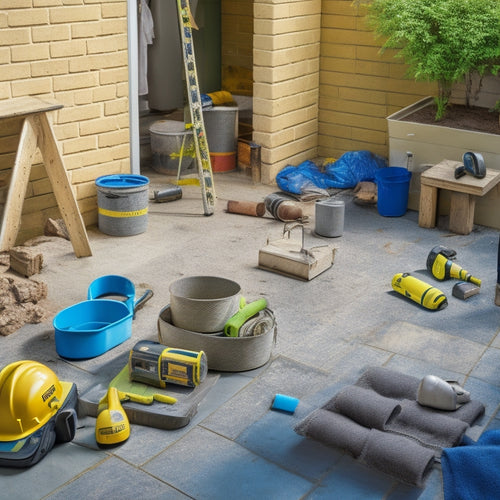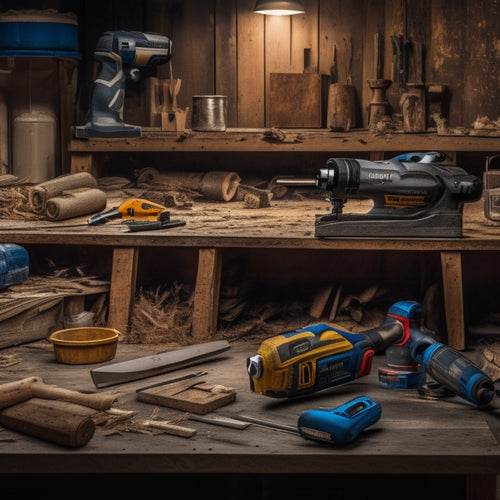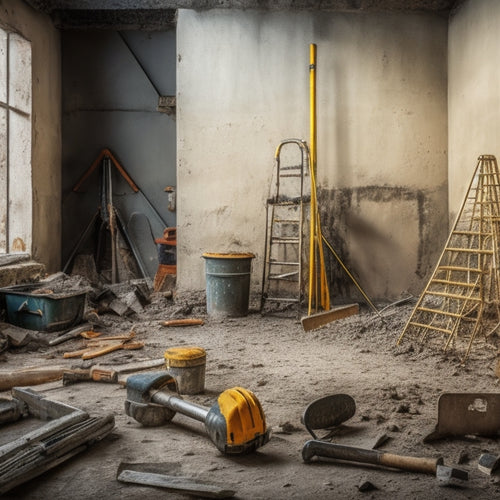
3 Best Grouting Tools for Block Wall Renovation
Share
When renovating a block wall, you'll need the right grouting tools to achieve a professional-looking finish and guarantee the wall's structural integrity. You'll want a grouting trowel that suits your needs, such as stainless steel for durability or rubber for tight spaces. A high-quality grout float with non-stick surfaces and an ergonomic design will make application a breeze. Finally, a grout scraper with curved or flat edges will help with effective removal in tight spaces. By choosing the right tools, you'll be well on your way to a successful renovation - and there's more to explore to ensure a flawless finish.
Key Takeaways
• For effective grout application, choose a grouting trowel that suits your project's size and scope, considering material, size, and handle features.
• Grout floats with high-quality materials, ergonomic design, and non-stick surfaces facilitate smooth grout application and reduce user fatigue.
• Grout scrapers are essential for removing excess grout, with curved or flat-edged options suitable for different surfaces and corners.
• Regular maintenance of grouting tools, including cleaning and drying, ensures peak performance and longevity.
• Selecting the right grouting tools, such as stainless steel or rubber options, helps achieve professional-looking results and withstands job demands.
Top Grouting Trowels for Blocks
As you begin renovating your block wall, selecting the right grouting trowel is essential for efficient and effective grout application. You'll want a trowel that can hold and spread the right amount of grout, while also withstanding the demands of the job.
When choosing a grouting trowel, consider the materials it's made of. Stainless steel, aluminum, and rubber are popular options, each with its own strengths and weaknesses. Stainless steel trowels are durable and resistant to corrosion, while aluminum trowels are lightweight and easy to maneuver. Rubber trowels are flexible and ideal for getting into tight spaces.
Trowel sizes also play an important role in grout application. A larger trowel (12-14 inches) is best for covering large areas quickly, while a smaller trowel (8-10 inches) is better suited for detail work and getting into tight spaces.
Some trowels also feature adjustable handles, allowing you to customize the fit to your hand. By selecting the right trowel material and size, you'll be well on your way to achieving professional-looking results.
Best Grout Floats for Walls
You'll need a reliable grout float to smooth out excess grout and create a clean finish, and the right one can make all the difference in achieving a professional-looking block wall renovation. A good grout float should be durable, easy to clean, and comfortable to use.
Here are some key features to look for in a grout float:
-
Float materials: Look for floats made from high-quality, durable materials such as stainless steel or rubber. These will withstand the rigors of grouting and last longer.
-
Ergonomic designs: An ergonomic design will reduce fatigue and make it easier to use the float for extended periods.
-
Non-stick surfaces: A non-stick surface will prevent grout from sticking to the float, making it easier to clean and use.
-
Adjustable handles: An adjustable handle will allow you to customize the fit to your hand, reducing strain and discomfort.
-
Rubber edges: Rubber edges will help to prevent scratching the block walls and guarantee a smooth finish.
Essential Grout Scrapers Needed
Two vital grout scrapers you must have in your toolkit are a grout scraper with a curved blade and a flat-edged scraper, which will help you remove excess grout from tight spaces and corners.
These scrapers are essential for effective grout removal techniques, allowing you to navigate complex areas with ease. The curved blade scraper is perfect for rounded corners and curved surfaces, while the flat-edged scraper is ideal for removing grout from flat surfaces and edges.
When using these scrapers, be sure to maintain a gentle yet firm pressure to avoid scratching the block wall surface.
It's also important to clean and maintain your scrapers regularly to prevent grout buildup and guarantee peak performance. Regularly rinse your scrapers with warm water and mild detergent, and dry them thoroughly to prevent rust or corrosion.
Frequently Asked Questions
What Safety Precautions Should I Take When Grouting a Block Wall?
When grouting a block wall, you'll want to prioritize safety. Start by wearing essential safety gear, including gloves, goggles, and a dust mask.
Guarantee good ventilation to avoid inhaling grout particles. Use grouting techniques that minimize mess and splatter, like holding the grout float at a 45-degree angle.
Mix grout in a well-ventilated area, and avoid overmixing, which can create hazardous dust. By taking these precautions, you'll protect yourself from potential hazards and get the job done efficiently.
Can I Use a Grout Gun for Block Wall Renovation Projects?
When tackling a block wall renovation, you're probably wondering if a grout gun is a viable option.
The answer is yes, you can use a grout gun! It offers benefits like increased speed and reduced fatigue.
Mastering grout gun techniques, such as maintaining consistent pressure and using the correct nozzle angle, will guarantee a professional-looking finish.
How Do I Remove Old Grout From Block Walls Without Damaging Them?
When tackling block wall renovation, you'll need to master grout removal techniques to avoid damaging the walls.
Start by applying a grout remover or a mixture of baking soda and water to the old grout. Let it sit, then use a stiff-bristled brush or scraper to gently remove the grout.
Avoid using harsh chemicals or excessive force, which can damage the blocks.
For tough grout, use a hammer and chisel or a grout saw, working carefully to preserve the block wall's integrity for ideal block wall maintenance.
What Type of Grout Is Best for Outdoor Block Wall Renovations?
You've finally broken free from the shackles of old grout, and now you're ready to rebuild.
For your outdoor block wall renovation, you'll need a grout that can withstand the elements.
You'll want to choose an outdoor grout type that's resistant to water and freeze-thaw cycles, such as epoxy-based or polyurethane-based grout.
Don't forget to select a grout color that complements your block walls and surrounding environment.
Can I Grout a Block Wall in Cold Weather Conditions?
When grouting a block wall, you need to take into account the cold weather effects on the process.
Typically, you should grout when the temperature is between 40°F and 80°F (4°C and 27°C). Check the grouting temperature guidelines on your product label, as some may vary.
If it's too cold, the grout may not set properly, leading to weak joints. Wait for a warmer day or use a cold-weather grout mix specifically designed for low temperatures.
Conclusion
You've got the right tools in your arsenal now - the top grouting trowels for blocks, the best grout floats for walls, and the essential grout scrapers needed.
Your block wall renovation project is ready to take shape.
Think of these tools as the conductor, violinist, and drummer in your grouting orchestra, working in harmony to produce a masterpiece.
With these tools, you'll be orchestrating a beautiful, grout-filled symphony in no time.
Related Posts
-

7 Patio Safety Tips for DIY Renovation Projects
As you begin your DIY patio renovation project, prioritize safety by evaluating the worksite for tripping hazards and...
-

10 Best Power Tools to Buy for Home Renovation
To tackle your home renovation project efficiently, you'll need the right power tools for the job. A cordless drill f...
-

What Tools to Rent for Block Wall Renovation
When renovating a block wall, it's vital to have the right tools for the job. You'll need demolition tools like pry b...


